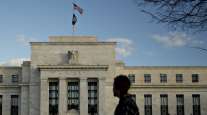Fed Says Tariff Concerns Cloud Otherwise Solid Growth Outlook

New tariffs and concerns over widening trade disputes cast a shadow over the Federal Reserve’s most recent survey of U.S. businesses even as all 12 regions reported continued robust job growth with few signs of overheating.
“Outlooks remained positive, but contacts in various sectors including manufacturing, agriculture and transportation expressed concern about the newly imposed and/or proposed tariffs,” the Fed said in its Beige Book report.
The report, based on anecdotal information collected by the Fed district banks in March and early April, showed companies continued to struggle to fill open jobs, particularly skilled positions. Despite that, “most districts reported wage growth as only modest.”
RELATED: IMF spots trouble for global economy after 2020
“Businesses were responding to labor shortages in a variety of ways, from raising pay to enhancing training to increasing their use of overtime and/or automation,” according to the report compiled by the Dallas Fed and released April 18 in Washington.
The report gives fodder to both sides of a debate among Fed policymakers over how long they can continue raising interest rates at a gradual pace without allowing a tight labor market to spark excessive inflation.
Unemployment remained at 4.1% in March for the sixth straight month, a level that hasn’t been bettered since 2000. Wages have responded only sluggishly, however. Year-on-year gains in hourly earnings rose by an average 2.7% in the year through March.
RELATED: Trump threatens endless NAFTA talks after walk-back on autos
RELATED: Treasury Secretary Steven Mnuchin says there’s ‘level of risk’ of US-China trade war
All 12 districts reported “modest” or “moderate” overall economic growth. Consumer spending increased in most regions, compared with the February report, when it was described as “mixed.”
The report also reflected a “scattered” incidence of companies passing price increases on to customers.
“Business generally anticipate further price increases in the months ahead, particularly for steel and building materials,” the report said.
Input prices continued to rise, especially in transportation and construction, where the costs of fuel and materials rose briskly. There also were “widespread reports that steel prices rose, sometimes dramatically, due to the new tariff.”
The Boston Fed provided a vivid example of the unintended consequences of the Trump administration’s effort to reduce the U.S. trade deficit through tariffs and new bilateral agreements. One unidentified company, hurt by levies on Chinese aluminum that caused prices to jump threefold, reported to the central bank, “These tariffs are now killing high-paying American manufacturing jobs and businesses.”




